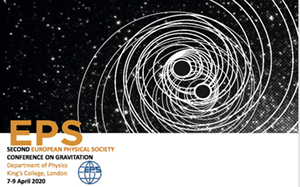Conveners
Recorded Talks: Experimental Challenges in Gravitational Wave Detection
- Fulvio Ricci (chair) (ROMA1)
We present the first observation of a parametric instability event in Advanced Virgo. The event occurred on January the 2020 during the locking acquisition procedure and involves for the first time, for a long-arm interferometer, a very high frequency mechanical mode. We will describe this event and the mean adopted for its dampening.
In the context of the future space mission, the Laser Interferometer Space Antenna (LISA), the stochastic background of gravitational waves (SGWB) will be very rich. LISA will simultaneously observe background signals of stochastic gravitational waves of different origins; orbitally modulated waveforms from galactic white dwarf binaries, a background produced by binaries of black holes and...
The Laser Interferometer Space Antenna mission LISA measures the strain in 2.5 million km distant free falling test masses couples, for detecting gravitational waves from galactic and extra galactic sources in the low frequency regime between 20 micro-Hz to 1 Hz. The instrument sensitivity is such that LISA would be able also to detect the effect of the gravitational field on its test masses...
We construct, for the first time, the time-domain gravitational wave strain waveform from the collapse of a strongly gravitating Abelian Higgs cosmic string loop in full general relativity. We show that the strain exhibits a large memory effect during merger, ending with a burst and the characteristic ringdown as a black hole is formed. Furthermore, we investigate the waveform and energy ...
We present the first search for the nonlinear memory from subsolar mass binary black hole (BBH) mergers during the second observing run of the LIGO and Virgo detectors. The oscillatory chirp signal from the inspiral and merger of low mass BBHs ($M _\mathrm{Total} \leq 0.4 M_\odot$) are at very high frequencies and fall outside the sensitivity band of the current ground-based detectors....
The passage of gravitational waves (GWs) through a binary perturbs the trajectories of the two bodies, potentially causing observable changes to their orbital parameters. In the presence of a stochastic GW background (SGWB) these changes accumulate over time, causing the binary orbit to execute a random walk through parameter space. In this talk I will present a powerful new formalism for...
Unlike for transient signals, the stochastic searches at LIGO-Virgo have the trouble of the signal not being greater than the intrinsic noise of the detector, and one should be particularly careful when trying to extract the gravitational wave signal from the data. Correlated noise coming from the Earth's electromagnetic field, in the form of Schumann resonances, could be comparable to the...
We have analysed the time evolution of the acceleration noise in the LISA Pathfinder mission throughout the course of the entire science operations, from March 2016 to July 2017.
The noise across the LISA bandwidth turned out to be remarkably stable over the course of the mission, with a monotonic and well-understood initial decrease over time associated to the the declining residual gas...
We study gravitational waves generated by binary systems within an extension of General Relativity which is described by the addition of quadratic in curvature tensor terms to the Einstein-Hilbert action. Treating quadratic gravity as an effective theory valid in the low energy/curvature regime, we argue that reliable calculations can be performed in the early inspiral phase, and furthermore,...
We present results on the search for the coalescence of compact binary mergers using convolutional neural networks and the LIGO/Virgo data. Two-dimensional images in time and frequency are used as input, and three sets of neural networks are trained separately for low mass, high mass and asymmetric mass compact binary coalescence events. We explored neural networks trained with input...
As part of the upgrade program, Virgo has just installed a new baffle equipped with photosensors that surrounds the end-mirror of the input mode-cleaner. This culminates more than two years of work at IFAE-Barcelona for the design and construction of a novel and innovative device to control and monitor stray light inside the experiment, a persistent source of noise in interferometers. It will...
The Advanced LIGO and Advanced Virgo detectors are now observing large numbers of gravitational-wave signals from compact binary coalescences, with 50 entries in the latest transient catalogue GWTC-2. With this rapidly growing event rate, our chances become better to detect rare astrophysical effects on these novel cosmic messengers. One such rare effect with a long and productive history in...
LISA Pathfinder (LPF) has been a successful ESA mission, operating between December 2015 and July 2017. The mission exceeded both its noise requirements and the more stringent requirements for LISA, demonstrating the feasibility of low-noise free-fall in the extended LISA frequency band between 20 microHz and 100 mHz.
Even though below the noise requirements, an excess noise with respect to...
In this talk I will present results on constraining cosmological parameters and theories of gravity beyond General Relativity (GR) using gravitational waves (GW). Specifically, we use the GW events GW170817 and GW190521, together with their proposed electromagnetic counterparts, and consider models with a time-varying Planck mass, large extra-dimensions, and a phenomenological parametrization...
In 2015 LISA Pathfinder (LPF), the LISA technological demonstrator, was launched from Kourou, French Guyana. The main goal of the demonstrator was to measure the differential acceleration noise between two freely falling test-masses, $\Delta g(t)$, such that $S^{1/2}_{\Delta g} < 30 ~\textrm{fm}/\textrm{s}^2/\sqrt{\textrm{Hz}}$ at 1 $\textrm{mHz}$. The in-orbit results showed an unprecedented...

